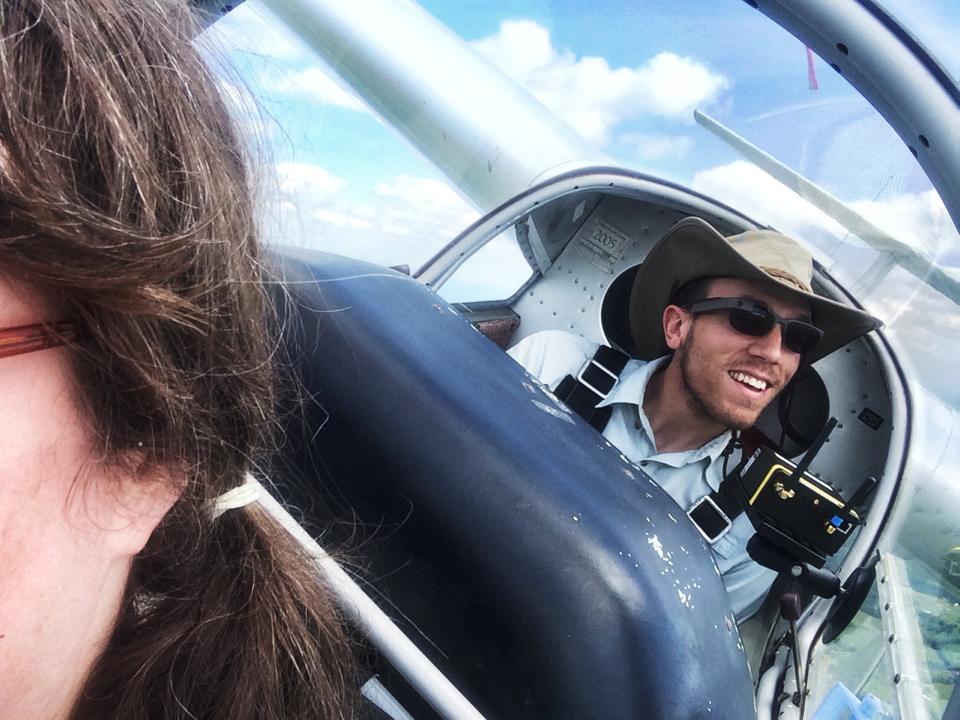Today was the first official practice day of the 2014 US Open Class Nationals at Montague—by all accounts, a fine, clear soaring day with high cloudbases and great views of Mount Shasta and the southern Cascades.
So, let me tell you all about my computer programming project.
Oh, I’m sure you’d prefer to read—and you can bet I’d like to write—all about an exciting practice day flight stretching east over Lava Beds National Monument to Medicine Lake, west into the southern Klamath Mountains, and up to the peak of Mount Shasta itself. Unfortunately for me (and, arguably, you), I wasn’t in the plane when it happened. Mike and his brother Joey were doing the flying; I was driving up from the Bay Area in my rental car.
I program computers in my day job, and when I’m not flying, I often program them in my spare time, too. This makes me a fun guy to hang out with. In any case, I’ve lately spent a fair amount of my hobby coding time working with Google Glass, the over-the-eye wearable computer that has attracted… a lot of media attention. There are lots of pictures out there of people wearing Glass. Here is one of me:

Back in PA: Flying with Glass in a Super Blaník
You can see my Glass unit perched above my right eye, attached to prescription glasses with a photochromic coating. (To answer a common question: it doesn’t restrict my vision appreciably: no more than ordinary glasses frames, and, like those, you learn to look around them.)
It is natural for pilots of a certain technical mien to wonder how Glass could be put to use while flying aircraft, though to be fair, it is natural for those pilots to wonder the same thing about most appliances smaller than a toaster oven. (Musician pilots may have similar thoughts about harmonicas, concertinas, and ukuleles; I couldn’t say.) The most obvious potential benefit of wearable computers is having flight data visible without having to glance back at the instrument panel, thereby increasing the amount of time a pilot could keep his/her eyes outside of the airplane, thereby increasing awareness of traffic and other hazards, etc.
With that in mind, I programmed Glass to show two visual displays. The first, seen above, shows a radar-like display of nearby traffic reported by the PowerFLARM collision avoidance/traffic advisory system—obviously a use case that benefits from not having to look at the panel. In the picture, the other traffic—that is, Dave Nadler‘s Antares 20E (YO) sitting on the ramp out there—appears as a triangle in the display. Let’s hope it never shows an aircraft that close during flight!
The other display shows what’s known as a “thermal assistant”. As you climb in a thermal, the strength of the lift you encounter determines how much the bar at 90° sticks out from the center of the radial plot. A lot of lift makes it push out pretty far, like it’s doing in the image above (where I’m “test flying” using a gliding simulator). Next, as you turn, the bars rotate in the opposite direction in the same amount. A properly centered thermal will have all bars the same length; thus, a pilot using a thermal assistant adjusts their turn in order to center the “blob” made from the bars.
Glider pilots will debate the merits of thermal assistants at great length; I’ll admit that the main reason I made this one is because it seemed like it would be fun. That said, it is true that thermaling is another time when it really pays to look outside of the plane, both to monitor the sources, indicators, and changes in the lift, and also to watch for other traffic that might be sharing your thermal.
There is a fair amount of additional electronics infrastructure at work here:

Left to right: battery, serial to IOIO/USB converter, PDA (an Android phone running XCSoar), PowerFLARM Portable (not the same as what’s in JOY).
including this homemade box for cramming old timey serial port data into a USB cable:
but that stuff can be saved for later.
The biggest use of Google Glass will probably have nothing to do with displaying flight data: it’ll be taking pictures during the contest. That said, I resorted to using my plain-old cell phone camera to film Mike and Joey landing about an hour after I turned up:



Day 0 at Montague: – Stepleton 34
Day 3 at Montague – Stepleton 34
That is a cool use of the Google Glass. How long does the Glass battery last in your application?
I have it plugged into an external battery pack, so I can’t really say! Probably not too long though…